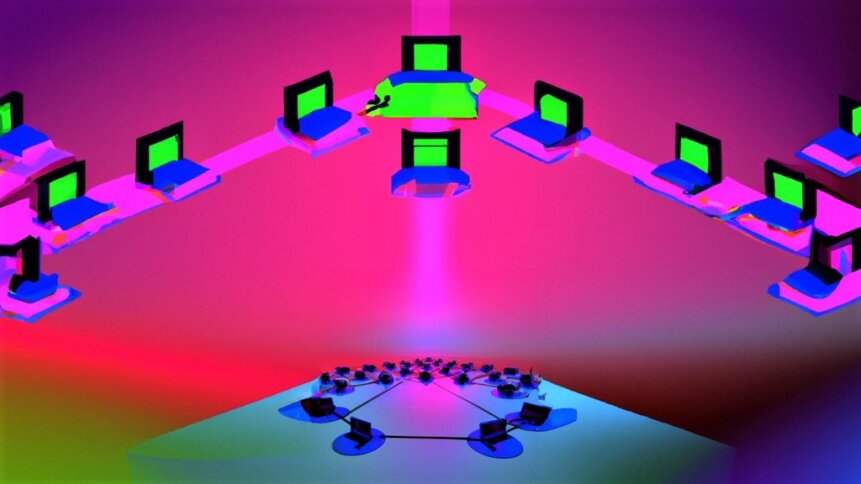Decentralized computing – a killer crypto app opportunity?

|
Getting your Trinity Audio player ready...
|
Graphics processing units (GPUs) are arguably one of the most prized hardware assets in computing. Shareholders lifted GPU maker NVIDIA into the trillion-dollar club when the firm announced ‘surging demand’ for its products and a quarterly revenue outlook of US $11 billion in a recent investor briefing. And the value of GPUs is opening up new ways of utilizing these high-performance chips, which includes decentralized computing – with rewards engineered thanks to a killer crypto app opportunity.
To understand how everything fits together, it’s worth highlighting some of the leading applications for GPUs. NVIDIA, which designs the majority of graphics cards produced globally, was founded in the early 1990s to address the shortcomings of general-purpose computing chips. Regular CPUs, while incredibly flexible programming tools, are less than ideal for processing complex graphics.
NVIDIA realized that it could accelerate 3D and multimedia tasks by having chips with a smaller, but graphics-specific, instruction set and many more cores – allowing superior parallel processing. Taking NVIDIA’s latest GeForce RTX 4090 graphics card as an example – the GPU has 16384 NVIDIA CUDA cores, whereas a top-end Intel i9 CPU has 24.
Being able to divide up tasks on a huge scale –thanks to the large numbers of cores – enables GPUs to master various use cases. NVIDIA’s trillion-dollar club success was driven by data center and cloud computing demand. More developers are integrating generative AI features into their enterprise applications, as awareness of the capabilities of large language models (LLMs) grows.
And GPUs have turned out to be ideal for training and fine-tuning LLMs, which has buoyed the market for NVIDIA’s products considerably. Meta’s AI Research SuperCluster featured 6,080 GPUs (housed in 760 NVIDIA DGX A100 systems) in its phase one configuration, and that GPU count is being upped to a massive 22,000 to add extra computing horsepower. Raising the number of available GPUs from 6,080 to 22,000 lifts AI training performance by more than 2.5x, according to Meta’s technical team.
Rendering and why decentralized computing could be a killer crypto app opportunity
But the explosion of interest in generative AI shouldn’t distract from one of the principal uses of GPUs. As the name suggests, graphics cards remain integral to computer-generated visuals, which in 2023 means not just video games, but various forms of entertainment as well as industrial applications.
Rendering – the process of creating 2D images from a 3D model – is used to create increasingly realistic computer graphics that can provide special effects in film and television and digital mock-ups of products and buildings – to give just a couple of examples. Video game visuals have come on leaps and bounds thanks to advances in rendering enabled through GPUs and graphics engines such as Unreal Engine, Unity, Cry Engine, and others used to create big-budget, triple-A titles.
And this brings us to Render Token and other blockchain-based solutions for democratizing access to digital resources such as Golem, which has recently unveiled a GPU computing proof-of-concept. Render Token puts to work idle GPUs by monetizing peer-to-peer processing of computer-generated images using OTOY’s Octane Render. As background, Octane Render has become a valuable software tool for creating digital cinema and other visual assets for clients.
“Most developers’ GPUs remain idle when they are not rendering their own work, leaving a wealth of potential power waiting to be tapped,” writes the team behind Render Network – distributed GPU rendering on the blockchain. “Once they’ve registered their idle GPUs on the Render Network, these GPU owners become Node Operators and are able to earn RNDR Tokens.”
The full details can be found in a white paper that explains how RNDR – a killer crypto app opportunity – enables GPU owners to receive payment for running rendering jobs on their machines for other users. Users post their rendering jobs on the community portal and receive a quote based on the processing demands of the task and supply of available GPUs on the decentralized computing network.
“Tiny computer, big project? The Render Network is your friend,” comments one of RNDR’s users in a Twitter video.
#OctaneRender revolutionized the way we render, but @OTOY took it even further with @RenderToken.
We asked our #digitalart #NFT community what they like about #RNDR, our #3D cloud rendering network, and what they told us was exactly what we hoped for: more room for creativity! pic.twitter.com/UZbKj5nujh
— The Render Network (@RenderToken) March 25, 2021
To action the job, payment is made (in RNDR) and a smart contract is created between the user and the GPU owner. As well as recording the transaction, the blockchain entry can also be used for digital rights management as the ledger provides a record of the work.
Full details on the GPUs that are supported for hardware owners thinking about offering rendering services and instructions on how to get started can be found on the Render Network Knowledge Base.
Airbnb model at the data center level
Cryptocurrencies aren’t everyone’s cup of tea. And if the hype train over utility tokens such as RNDR leaves you uneasy, there are still other ways to benefit from underutilized GPUs. For example, FluidStack – which was founded by Oxford University students who noticed that machine learning researchers were paying high prices for cloud compute, at the same time as relatively powerful gaming rigs owned by their friends were sat unused 75% of the time – is now applying Airbnb for GPUs at the data center level.
FluidStack, which today offers access to more than 47,000 GPU servers across six continents, allows data center operators to monetize excess capacity. And customers benefit from more affordable pricing. According to FluidStack, users pay on-demand fees of just US $11.92 per hour compared with US $30 – 40 for equivalent services provided by major cloud vendors.
In terms of requirements, FluidStack lists an example setup of 4x RTX A6000 GPUs, and data center providers must host multiple NVIDIA GPU servers in a secure environment. Also, the Airbnb for GPU provider has a preference for Tier 2+ data centers based on customer needs.
The growing application value of GPUs is leading to new models for accessing compute for rendering and other tasks. And these initiatives are giving hardware owners an incentive to boost the productivity of GPUs rather than have expensive silicon left sitting idle.











